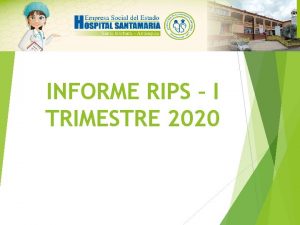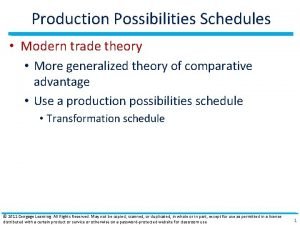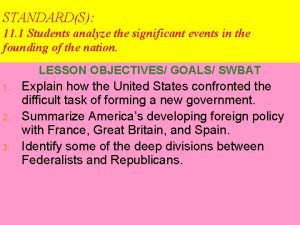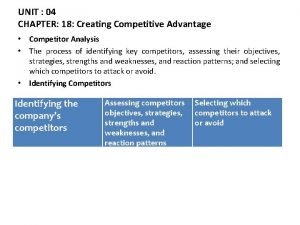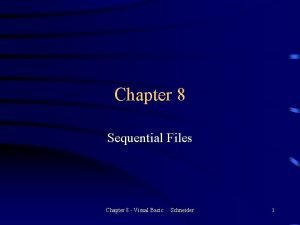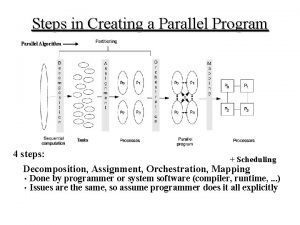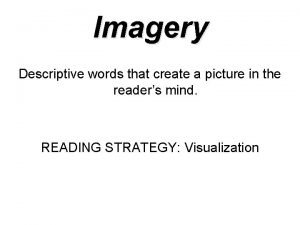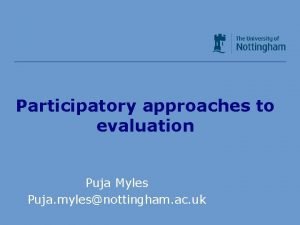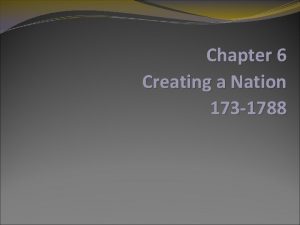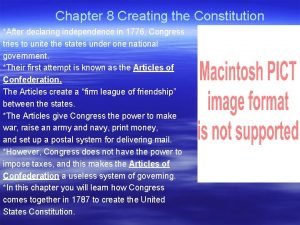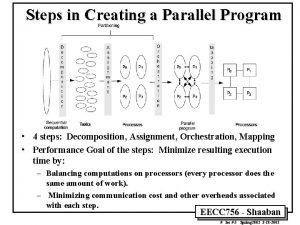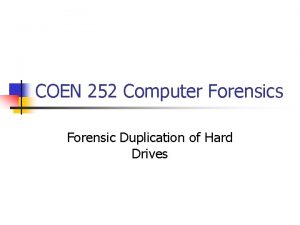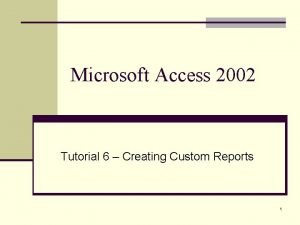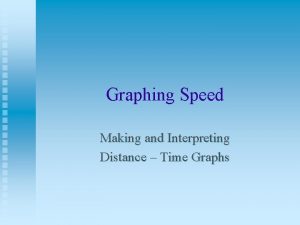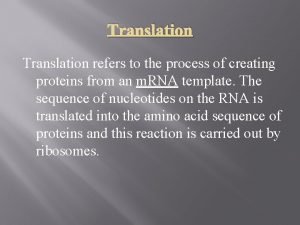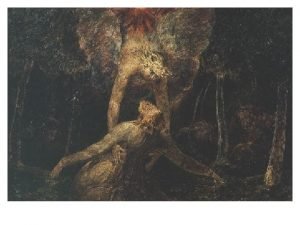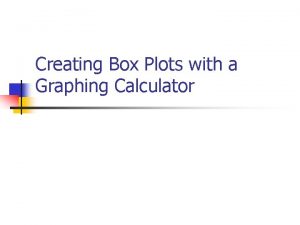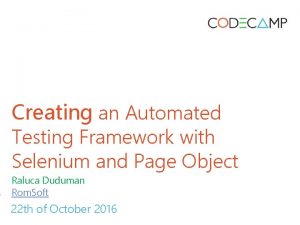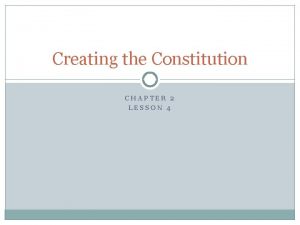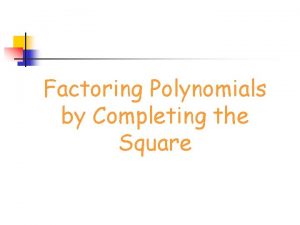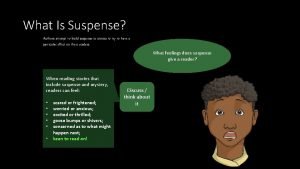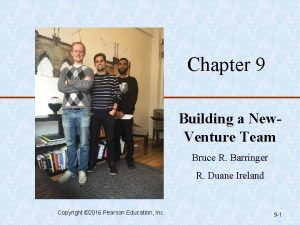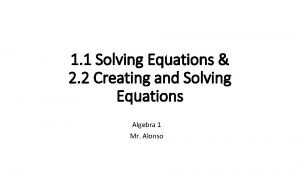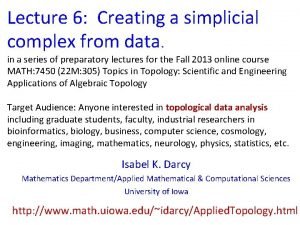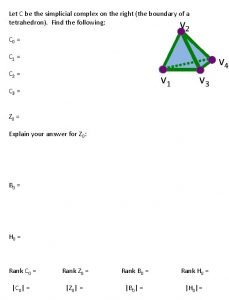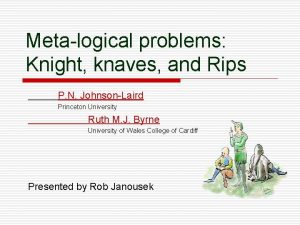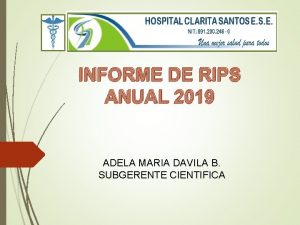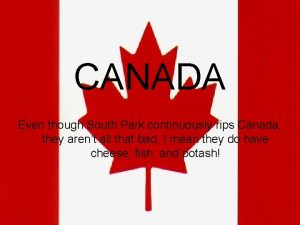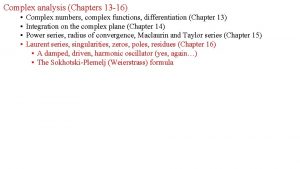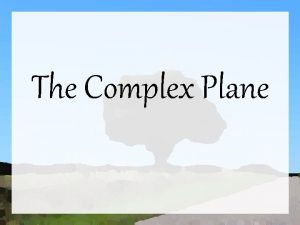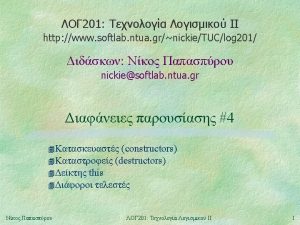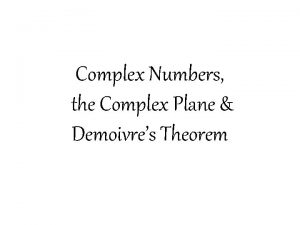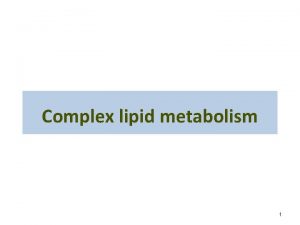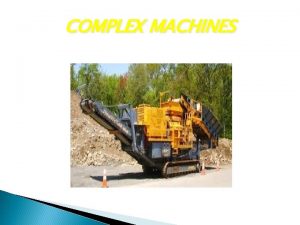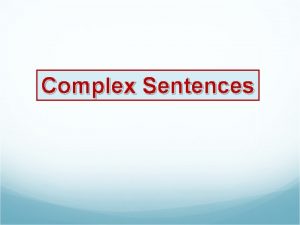Creating the Vietoris Rips simplicial complex 0 Start































































































































- Slides: 127

Creating the Vietoris Rips simplicial complex 0. ) Start by adding 0 -dimensional data points Note: we only need a definition of closeness between data points. The data points do not need to be actual points in Rn

Topology and Data. Gunnar Carlsson www. ams. org/journals/bull/2009 -46 -02/S 0273 -0979 -09 -01249 -X

http: //link. springer. com/article/10. 1007%2 Fs 00454 -004 -1146 -y

http: //link. springer. com/article/10. 1007/s 00454 -002 -2885 -2

U U U A filtered complex is an increasing sequence of simplicial complexes: C 0 C 1 C 2 … http: //link. springer. com/article/10. 1007%2 Fs 00454 -004 -1146 -y

U … C 05 U U C 20 U U {a, b, c} is in C 42 C 10 U U a, b is in C 00 U A filtered complex is an increasing sequence of simplicial complexes: C 0 C 1 C 2 … C 52 http: //link. springer. com/article/10. 1007%2 Fs 00454 -004 -1146 -y

3 2 1 0 C 2 C 1 C 0 0 H 0 = Z 0/B 0 = (kernel of 0)/ (image of null space of M 0 = column space of M 1 Rank H 0 = Rank Z 0 – Rank B 0 1)

3 C 2 2 C 1 1 C 0 0 0 H 0 = Z 0/B 0 = (kernel of 0)/ (image of null space of M 0 = column space of M 1 Rank H 0 = Rank Z 0 – Rank B 0 1)

0 0 0 http: //link. springer. com/article/10. 1007%2 Fs 00454 -004 -1146 -y

0 0 0 http: //link. springer. com/article/10. 1007%2 Fs 00454 -004 -1146 -y

0 0 0 H 0 = Z 0/B 0 = (kernel of 0)/ (image of 1) http: //link. springer. com/article/10. 1007%2 Fs 00454 -004 -1146 -y

0 0 0 i, 0 H 0 = i Z 0 / i B 0 0 = (kernel of 0)/ (image of 1) http: //link. springer. com/article/10. 1007%2 Fs 00454 -004 -1146 -y

0 0 0 0, 1 H 0 = 0 0+1 Z 0 / ( B 0 U 0 0 Z 0 ) http: //link. springer. com/article/10. 1007%2 Fs 00454 -004 -1146 -y

0 0 0 0, 2 H 0 = 0 0+2 Z 0 / ( B 0 U 0 0 Z 0 ) http: //link. springer. com/article/10. 1007%2 Fs 00454 -004 -1146 -y

0 0 0 i, 1 H 0 = i i+1 Z 0 / ( B 0 U 0 i Z 0 ) http: //link. springer. com/article/10. 1007%2 Fs 00454 -004 -1146 -y

= i i+2 Z 0 / ( B 0 U i, 2 H 0 i Z 0 ) http: //link. springer. com/article/10. 1007%2 Fs 00454 -004 -1146 -y

U p-persistent kth homology group: i, p i i+p Hk = Z k / ( B k i Zk ) http: //link. springer. com/article/10. 1007%2 Fs 00454 -004 -1146 -y

o 2 o 1 C 2 C 1 C 0 H 1 = Z 1/B 1 = (kernel of o 1 )/ (image of o 2 ) null space of M 1 = column space of M 2 <e 1 + e 2 + e 3, e 4 + e 5 + e 6> = <e 4 + e 5 + e 6> Rank H 1 = Rank Z 1 – Rank B 1 = 2 – 1 = 1

Topological Persistence and Simplification, 2002 Figure from: Computing Persistent Homology, 2005 Let s be a k-simplex s is a positive simplex if it creates a cycle when it enters. s is a negative simplex if it destroys a cycle when it enters. http: //link. springer. com/article/10. 1007%2 Fs 00454 -004 -1146 -y

Computing Persistent Homology by Afra Zomorodian, Gunnar Carlsson 0 0 1 1 2 2 3 4 a b c d ab bc cd ad ac abc acd 0 1 2 3 4 5 6 7 8 9 5 10 http: //link. springer. com/article/10. 1007%2 Fs 00454 -004 -1146 -y

Computing Persistent Homology by Afra Zomorodian, Gunnar Carlsson 0 0 1 1 2 2 3 4 5 + + - - - + + - - a b c d ab bc cd ad ac abc acd 0 1 2 3 4 5 6 7 8 4 5 6 10 9 ad ac a, b b, c c, d 9 10 http: //link. springer. com/article/10. 1007%2 Fs 00454 -004 -1146 -y

0 0 1 1 2 2 3 4 5 + + - - - + + - - a b c d ab bc cd ad ac abc acd 0 1 2 3 4 5 6 7 8 4 5 6 10 9 ad ac a, b b, c c, d a 0 1 3 b 0 c 1 d 1 ab 1 bc 1 cd 2 ad 2 9 10 ac 3 abc 4 acd 5

[ a 0 1 3 b 0 [ c 1 [ ) d 1 ) ) [ ab 1 bc 1 cd 2 ad 2 [ ) ) ac 3 abc 4 acd 5

[ a 0 1 3 b 0 [ c 1 [ ) d 1 ) ) [ ab 1 bc 1 cd 2 ad 2 [ ) ) ac 3 abc 4 acd 5

a 0 b 0 c 1 d 1 ab 1 bc 1 cd 2 ac 3 abc 4 acd 5 1 3 [ t 0 1 3 [ ) t 1 ) [ [ t 2 t 3 ) t 4 ) t 5

[ a 0 b 0 [ c 1 [ ) d 1 ) ) [ [ ab 1 bc 1 cd 2 ad 2 ) ) ac 3 abc 4 acd 5 1 3 [ t 0 1 3 [ ) t 1 ) [ [ t 2 t 3 ) t 4 ) t 5

Topological Persistence and Simplification: link. springer. com/article/10. 1007/s 00454 -002 -2885 -2

Topological Persistence and Simplification: link. springer. com/article/10. 1007/s 00454 -002 -2885 -2

Topological Persistence and Simplification: link. springer. com/article/10. 1007/s 00454 -002 -2885 -2

Discriminative persistent homology of brain networks, 2011 Hyekyoung Lee Chung, M. K. ; Hyejin Kang; Bung-Nyun Kim; Dong Soo Lee Constructing functional brain networks with 97 regions of interest (ROIs) extracted from FDG-PET data for 24 attention-deficit hyperactivity disorder (ADHD), 26 autism spectrum disorder (ASD) and 11 pediatric control (Ped. Con). Data = measurement fj taken at region j Graph: 97 vertices representing 97 regions of interest edge exists between two vertices i, j if correlation between fj and fj ≥ threshold How to choose threshold? Don’t, instead use persistent homology


Vertices = Regions of Interest Create Rips complex by growing epsilon balls (i. e. decreasing threshold) where distance between two vertices is given by where fi = measurement at location i

Discriminative persistent homology of brain networks, 2011 Hyekyoung Lee Chung, M. K. ; Hyejin Kang; Bung-Nyun Kim; Dong Soo Lee Constructing functional brain networks with 97 regions of interest (ROIs) extracted from FDG-PET data for 24 attention-deficit hyperactivity disorder (ADHD), 26 autism spectrum disorder (ASD) and 11 pediatric control (Ped. Con). Data = measurement fj taken at region j Graph: 97 vertices representing 97 regions of interest edge exists between two vertices i, j if correlation between fj and fj ≥ threshold How to choose threshold? Don’t, instead use persistent homology

2012 Ignoble Prize The Ig Nobel Prizes honor achievements that make people LAUGH, and then THINK. http: //www. improbable. com/ig/ Activated f. MRI of dead salmon The salmon was shown images of people in social situations, either socially inclusive situations or socially exclusive situations. The salmon was asked to respond, saying how the person in the situation must be feeling. http: //blogs. scientificamerican. com/sc icurious-brain/2012/09/25/ignobelprize-in-neuroscience-the-deadsalmon-study/ compared to other voxels

© 2008 I. K. Darcy. All rights reserved

http: //www. ploscompbiol. org/article/info%3 Adoi%2 F 10. 1371%2 Fjournal. pcbi. 1000205 2008 First paper to use only the spiking activity of place cells to determine the topology (and geometry) of the environment using homology (and graphs).

Edvard Moser May-Britt Moser John O’Keefe http: //www. nature. com/news/nobel-prize-for-decoding-brain-s-sense-of-place-1. 16093

http: //www. nature. com/news/neuroscience-brains-ofnorway-1. 16079 May-Britt Moser Edvard Moser John O’Keefe http: //www. nature. com/news/nobel-prize-for-decoding-brain-s-sense-of-place-1. 16093

place cells = neurons in the hippocampus that are involved in spatial navigation http: //en. wikipedia. org/wiki/File: Gray 739 -emphasizing-hippocampus. png http: //en. wikipedia. org/wiki/File: Hippocampus. gif http: //en. wikipedia. org/wiki/File: Hippocampal-pyramidal-cell. png

http: //www. nytimes. com/2014/10/07/science /nobel-prize-medicine. html

http: //www. ploscompbiol. org/article/info%3 Adoi%2 F 10. 1371%2 Fjournal. pcbi. 1002581

http: //www. ntnu. edu/kavli/research/grid-cell-data

http: //www. ploscompbiol. org/article/info%3 Adoi%2 F 10. 1371%2 Fjournal. pcbi. 1000205 2008 First paper to use only the spiking activity of place cells to determine the topology (and geometry) of the environment using homology (and graphs).

Place field = region in space where the firing rates are significantly above baseline place cells = neurons in the hippocampus that are involved in spatial navigation http: //www. ploscompbiol. org/article/info%3 Adoi%2 F 10. 1371%2 Fjournal. pcbi. 1002581

How can the brain understand the spatial environment based only on action potentials (spikes) of place cells? http: //upload. wikimedia. org/wikipedia/en/5/5 e/Place_Cell_Spiking_Activity_Example. png









Time Cycles

Time Cycles

Time Cycles

Time Cycles

Time Cycles

Time Cycles

Time Cycles

Time Cycles

Time Cycles

Time Cycles

Time Cycles

Time Cycles

Time Cycles

How can the brain understand the spatial environment based only on action potentials (spikes) of place cells? http: //upload. wikimedia. org/wikipedia/en/5/5 e/Place_Cell_Spiking_Activity_Example. png

Place field = region in space where the firing rates are significantly above baseline http: //www. ploscompbiol. org/article/info%3 Adoi%2 F 10. 1371%2 Fjournal. pcbi. 1000205

Idea: Can recover the topology of the space traversed by the mouse by looking only at the spiking activity of place cells. http: //www. ploscompbiol. org/article/info%3 Adoi%2 F 10. 1371%2 Fjournal. pcbi. 1000205

Creating a simplicial complex

Creating a simplicial complex 1. ) Adding 1 -dimensional edges (1 -simplices) Add an edge between data points that are “close”

Creating the Čech simplicial complex 1. ) B 1 … Bk+1 ≠ 0⁄ , create k-simplex {v 1, . . . , vk+1}. U U

Creating the Čech simplicial complex 1. ) B 1 … Bk+1 ≠ 0⁄ , create k-simplex {v 1, . . . , vk+1}. U U

Consider X an arbitrary topological space. Let V = {Vi | i = 1, …, n } where Vi X, The nerve of V = N(V) where The k -simplices of N(V) = nonempty intersections of k +1 distinct elements of V. For example, Vertices = elements of V Edges = pairs in V which intersect nontrivially. Triangles = triples in V which intersect nontrivially. http: //www. math. upenn. edu/~ghrist/EATchapter 2. pdf

Consider X an arbitrary topological space. Čech complex = Let V = {Vi | i = 1, …, n } where Vi Mathematical X, nerve, not biological nerve The nerve of V = N(V) where The k -simplices of N(V) = nonempty intersections of k +1 distinct elements of V. For example, Vertices = elements of V Edges = pairs in V which intersect nontrivially. Triangles = triples in V which intersect nontrivially. http: //www. math. upenn. edu/~ghrist/EATchapter 2. pdf

Creating the Čech simplicial complex 1. ) B 1 … Bk+1 ≠ 0⁄ , create k-simplex {v 1, . . . , vk+1}. U U

Mathematical Nerve Lemma: If V is a finite collection of subsets of X with all non-empty intersections of subcollections of V contractible, then N(V) is homotopic to the union of elements of V. http: //www. math. upenn. edu/~ghrist/EATchapter 2. pdf

Idea: Can recover the topology of the space traversed by the mouse by looking only at the spiking activity of place cells. Vertices = place cells Add simplex if place cells co-fare within a specified time period http: //www. ploscompbiol. org/article/info%3 Adoi%2 F 10. 1371%2 Fjournal. pcbi. 1000205

Cell group = collection of place cells that co-fire within a specified time period (above a specified threshold). Simplices correspond to cell groups. dimension of simplex = number of place cells in cell group - 1 http: //www. ploscompbiol. org/article/info%3 Adoi%2 F 10. 1371%2 Fjournal. pcbi. 1000205

Idea: Can recover the topology of the space traversed by the mouse by looking only at the spiking activity of place cells. Proof of concept: Data obtained via computer simulations of mouse trajectories using biologically relevant parameters. http: //www. ploscompbiol. org/article/info%3 Adoi%2 F 10. 1371%2 Fjournal. pcbi. 1000205

a smoothed random-walk trajectory was generated, with speed = 0. 1 L/s, which was constrained to ‘‘bounce’’ off boundaries and stay within the environment. The total duration of each simulated trajectory was 50 minutes. http: //www. ploscompbiol. org/article/info%3 Adoi%2 F 10. 1371%2 Fjournal. pcbi. 1000205

For each of 300 trials, N= 70 place fields were generated as disks of radii 0. 1 L to 0. 15 L, with radii and centers chosen uniformly at random. Centers were chosen initially uniformly at random from uncovered space. Once all space covered, remaining centers chosen at random. http: //www. ploscompbiol. org/article/info%3 Adoi%2 F 10. 1371%2 Fjournal. pcbi. 1000205

For each place cell in each trial, an average firing rate was chosen uniformly at random from the interval 2– 3 Hz. A spike train was generated from the trajectory and corresponding place field as an inhomogeneous Poisson process with constant rate when the trajectory passed inside the place field, and zero outside, so that the overall firing rate was preserved.

Add noise. r% spikes were deleted from the spike train, and then added back to the spike train at random times, irrespective of position along trajectory, so as to preserve overall firing rate. Control : ‘Shuffled’ data sets were constructed by randomly choosing cells from each of the five environments, and pooling them together to yield population spiking activity that did not come from a single environment.

Assumptions about Place Fields (1) Place fields are omni-directional I. e. direction does not affect the firing rate. http: //www. ploscompbiol. org/article/info%3 Adoi%2 F 10. 1371%2 Fjournal. pcbi. 1000205

Assumptions about Place Fields (1) Place fields are omni-directional Correct assumption in open field. Not correct in linear track. Place cells can also encode angles and directions http: //www. ploscompbiol. org/article/info%3 Adoi%2 F 10. 1371%2 Fjournal. pcbi. 1000205

Assumptions about Place Fields (1) Place fields are omni-directional (2) Place fields have been previously formed and are stable. http: //www. ploscompbiol. org/article/info%3 Adoi%2 F 10. 1371%2 Fjournal. pcbi. 1000205

Assumptions about Place Fields (1) Place fields are omni-directional (2) Place fields have been previously formed and are stable. Note: the hippocampus can undergo rapid context dependent remapping. http: //www. ploscompbiol. org/article/info%3 Adoi%2 F 10. 1371%2 Fjournal. pcbi. 1000205

Assumptions about Place Fields (1) Place fields are omni-directional (2) Place fields have been previously formed and are stable. Note: the hippocampus can undergo rapid context dependent remapping. http: //www. ploscompbiol. org/article/info%3 Adoi%2 F 10. 1371%2 Fjournal. pcbi. 1000205

Assumptions about Place Fields (1) Place fields are omni-directional (2) Place fields have been previously formed and are stable. Note: the hippocampus can undergo rapid context dependent remapping. http: //www. ploscompbiol. org/article/info%3 Adoi%2 F 10. 1371%2 Fjournal. pcbi. 1000205

Assumptions about Place Fields (1) Place fields are omni-directional (2) Place fields have been previously formed and are stable. Note: the hippocampus can undergo rapid context dependent remapping. Nature 2002, Long-term plasticity in hippocampal place-cell representation of environmental geometry, Colin Lever, Tom Wills, Francesca Cacucci, Neil Burgess, John O'Keefe http: //www. nature. com/nature/journal/v 416/n 6876/fig_tab/416090 a_F 2. html

Remodeling: the hippocampus can undergo rapid context dependent remapping. http: //arxiv. org/abs/q-bio/0702052

Assumptions about Place Fields (1) Place fields are omni-directional (2) Place fields have been previously formed and are stable. (3) The collection of place fields corresponding to observed cells covers the entire traversed environment. I. e. , the trajectory must be dense enough to sample the majority of cell groups. http: //www. ploscompbiol. org/article/info%3 Adoi%2 F 10. 1371%2 Fjournal. pcbi. 1000205

Assumptions about Place Fields (1) Place fields are omni-directional (2) Place fields have been previously formed and are stable. (3) The collection of place fields corresponding to observed cells covers the entire traversed environment. Biologically: place cells multiply cover the environment. http: //www. ploscompbiol. org/article/info%3 Adoi%2 F 10. 1371%2 Fjournal. pcbi. 1000205

Assumptions about Place Fields (1) Place fields are omni-directional (2) Place fields have been previously formed and are stable. (3) The collection of place fields corresponding to observed cells covers the entire traversed environment. For accurate computation of the nth homology group Hn, we need up to (n+1)-fold intersections to be detectable via cell groups. http: //www. ploscompbiol. org/article/info%3 Adoi%2 F 10. 1371%2 Fjournal. pcbi. 1000205

Assumptions about Place Fields (1) Place fields are omni-directional (2) Place fields have been previously formed and are stable. (3) The collection of place fields corresponding to observed cells covers the entire traversed environment. (4) The holes/obstacles are larger than the diameters of place fields. http: //www. ploscompbiol. org/article/info%3 Adoi%2 F 10. 1371%2 Fjournal. pcbi. 1000205

Assumptions about Place Fields (5) Each (connected) component field of a single or multipeaked place field is convex. (6) Background activity is low compared to the firing inside the place fields. (7) Place fields are roughly circular and have similar sizes, as is typical in dorsal hippocampus [41, 42]. http: //www. ploscompbiol. org/article/info%3 Adoi%2 F 10. 1371%2 Fjournal. pcbi. 1000205

For each place cell in each trial, an average firing rate was chosen uniformly at random from the interval 2– 3 Hz. A spike train was generated from the trajectory and corresponding place field as an inhomogeneous Poisson process with constant rate when the trajectory passed inside the place field, and zero outside, so that the overall firing rate was preserved. Noise added.

Cell group = collection of place cells that co-fire within a specified time period (above a specified threshold). Simplices correspond to cell groups. dimension of simplex = number of place cells in cell group - 1 http: //www. ploscompbiol. org/article/info%3 Adoi%2 F 10. 1371%2 Fjournal. pcbi. 1000205

Homology calculated via the GAP software package: http: //www. cis. ude l. edu/linbox/gap. ht ml Simplices correspond to cell groups. dimension of simplex = number of place cells in cell group - 1 http: //www. ploscompbiol. org/article/info%3 Adoi%2 F 10. 1371%2 Fjournal. pcbi. 1000205

Recovering the topology Trial is correct if Hi correct for i = 0, 1, 2, 3, 4. http: //www. ploscompbiol. org/article/info%3 Adoi%2 F 10. 1371%2 Fjournal. pcbi. 1000205

Geometry? ? ?

http: //www. ploscompbiol. org/article/info%3 Adoi%2 F 10. 1371%2 Fjournal. pcbi. 1000205 First paper to use only the spiking activity of place cells to determine the topology (and geometry) of the environment using homology (and graphs).

http: //www. ploscompbiol. org/article/info%3 Adoi%2 F 10. 1371%2 Fjournal. pcbi. 1000205

m 1 = 1 mk = 1 – p √(k-1)/N where N = number of cells. http: //www. ploscompbiol. org/article/info%3 Adoi%2 F 10. 1371%2 Fjournal. pcbi. 1000205

Normalize distance so mean pairwise distances same for both simulated and calculated data. http: //www. ploscompbiol. org/article/info%3 Adoi%2 F 10. 1371%2 Fjournal. pcbi. 1000205

http: //www. ploscompbiol. org/article/info%3 Adoi%2 F 10. 1371%2 Fjournal. pcbi. 1000205

Normalize distance so mean pairwise distances same for both simulated and calculated data. http: //www. ploscompbiol. org/article/info%3 Adoi%2 F 10. 1371%2 Fjournal. pcbi. 1000205

http: //www. ploscompbiol. org/article/info%3 Adoi%2 F 10. 1371%2 Fjournal. pcbi. 1000205

Multipeaked place fields http: //www. ploscompbiol. org/article/info%3 Adoi%2 F 10. 1371%2 Fjournal. pcbi. 1000205


http: //www. ploscompbiol. org/article/info%3 Adoi%2 F 10. 1371%2 Fjournal. pcbi. 1000205


http: //www. ploscompbiol. org/article/info%3 Adoi%2 F 10. 1371%2 Fjournal. pcbi. 1002581 2012

2012

2012


Data obtained via computer simulations

http: //www. ntnu. edu/kavli/research/grid-cell-data

Note the above examples use the Čech complex to determine the topology of the mouse environment. But often in topological data analysis for computational efficiency, one uses the Rips complex instead of the Čech complex. Unfortunately there is no nerve lemma for the Rips complex.

Creating the Vietoris Rips simplicial complex 0. ) Start by adding 0 -dimensional data points Note: we only need a definition of closeness between data points. The data points do not need to be actual points in Rn

Creating the Vietoris Rips simplicial complex Step 0. ) Start by adding data points = 0 -dimensional vertices (0 -simplices)

Creating the Vietoris Rips simplicial complex 1. ) Adding 1 -dimensional edges (1 -simplices) Add an edge between data points that are “close”

Creating the Vietoris Rips simplicial complex 2. ) Add all possible simplices of dimensional > 1.

Vietoris Rips complex = flag complex = clique complex 2. ) Add all possible simplices of dimensional > 1.

Creating the Čech simplicial complex 1. ) B 1 … Bk+1 ≠ 0⁄ , create k-simplex {v 1, . . . , vk+1}. U U

Creating the Čech simplicial complex 1. ) B 1 … Bk+1 ≠ 0⁄ , create k-simplex {v 1, . . . , vk+1}. U U
 Norma de los rips
Norma de los rips Rips odontologia
Rips odontologia Johan schepers de rips
Johan schepers de rips Rips örgü
Rips örgü Poem remains by simon armitage
Poem remains by simon armitage Boek 100 jaar de rips
Boek 100 jaar de rips If you gotta start somewhere why not here
If you gotta start somewhere why not here Jumpstart triage age
Jumpstart triage age Simple compound complex and compound-complex sentences quiz
Simple compound complex and compound-complex sentences quiz Freuds theories
Freuds theories Miliary tb
Miliary tb Rorschach test answers
Rorschach test answers Simple, compound-complex rules
Simple, compound-complex rules Electra complex vs oedipus complex
Electra complex vs oedipus complex Thơ thất ngôn tứ tuyệt đường luật
Thơ thất ngôn tứ tuyệt đường luật Làm thế nào để 102-1=99
Làm thế nào để 102-1=99 Chúa yêu trần thế alleluia
Chúa yêu trần thế alleluia Sự nuôi và dạy con của hươu
Sự nuôi và dạy con của hươu đại từ thay thế
đại từ thay thế Vẽ hình chiếu vuông góc của vật thể sau
Vẽ hình chiếu vuông góc của vật thể sau Công của trọng lực
Công của trọng lực Tỉ lệ cơ thể trẻ em
Tỉ lệ cơ thể trẻ em Thế nào là mạng điện lắp đặt kiểu nổi
Thế nào là mạng điện lắp đặt kiểu nổi Lời thề hippocrates
Lời thề hippocrates Vẽ hình chiếu đứng bằng cạnh của vật thể
Vẽ hình chiếu đứng bằng cạnh của vật thể Quá trình desamine hóa có thể tạo ra
Quá trình desamine hóa có thể tạo ra Phản ứng thế ankan
Phản ứng thế ankan Các môn thể thao bắt đầu bằng từ đua
Các môn thể thao bắt đầu bằng từ đua Khi nào hổ mẹ dạy hổ con săn mồi
Khi nào hổ mẹ dạy hổ con săn mồi Dạng đột biến một nhiễm là
Dạng đột biến một nhiễm là điện thế nghỉ
điện thế nghỉ Thế nào là sự mỏi cơ
Thế nào là sự mỏi cơ Trời xanh đây là của chúng ta thể thơ
Trời xanh đây là của chúng ta thể thơ Voi kéo gỗ như thế nào
Voi kéo gỗ như thế nào Thiếu nhi thế giới liên hoan
Thiếu nhi thế giới liên hoan Tia chieu sa te
Tia chieu sa te Một số thể thơ truyền thống
Một số thể thơ truyền thống Các châu lục và đại dương trên thế giới
Các châu lục và đại dương trên thế giới Thế nào là hệ số cao nhất
Thế nào là hệ số cao nhất Sơ đồ cơ thể người
Sơ đồ cơ thể người Ng-html
Ng-html Số nguyên là gì
Số nguyên là gì Tư thế ngồi viết
Tư thế ngồi viết Hát kết hợp bộ gõ cơ thể
Hát kết hợp bộ gõ cơ thể đặc điểm cơ thể của người tối cổ
đặc điểm cơ thể của người tối cổ Cách giải mật thư tọa độ
Cách giải mật thư tọa độ Glasgow thang điểm
Glasgow thang điểm ưu thế lai là gì
ưu thế lai là gì Thẻ vin
Thẻ vin Cái miệng xinh xinh thế chỉ nói điều hay thôi
Cái miệng xinh xinh thế chỉ nói điều hay thôi Các châu lục và đại dương trên thế giới
Các châu lục và đại dương trên thế giới Bổ thể
Bổ thể Từ ngữ thể hiện lòng nhân hậu
Từ ngữ thể hiện lòng nhân hậu Tư thế ngồi viết
Tư thế ngồi viết Diễn thế sinh thái là
Diễn thế sinh thái là Thế nào là giọng cùng tên
Thế nào là giọng cùng tên Creating a positive classroom atmosphere
Creating a positive classroom atmosphere Cladistics
Cladistics Create your own planet
Create your own planet Chapter 6 creating a nation
Chapter 6 creating a nation The american people creating a nation and a society
The american people creating a nation and a society Creating production possibilities schedules and curves
Creating production possibilities schedules and curves Creating a new nation
Creating a new nation Competitor centered company
Competitor centered company Culture vs formalization
Culture vs formalization Outline steps to be taken when creating a sequential file
Outline steps to be taken when creating a sequential file Chapter 18 creating competitive advantage
Chapter 18 creating competitive advantage What is the correct steps in creating a parallel program
What is the correct steps in creating a parallel program Creating and capturing customer value
Creating and capturing customer value Creating a strategy supportive culture
Creating a strategy supportive culture How to write a thesis for ap world history
How to write a thesis for ap world history Creating an english environment
Creating an english environment Equations and inequalities word problems
Equations and inequalities word problems Create your own society project
Create your own society project Customer driven marketing strategy steps
Customer driven marketing strategy steps How to build a cloud center of excellence gartner
How to build a cloud center of excellence gartner Cohesive thesis statement
Cohesive thesis statement Excel module 1: creating a worksheet and a chart
Excel module 1: creating a worksheet and a chart Visually descriptive words
Visually descriptive words Creating abn tests
Creating abn tests Inner critic inner defender inner guide
Inner critic inner defender inner guide Lisa is 10 centimeters taller than
Lisa is 10 centimeters taller than Puja myles
Puja myles What is customer value satisfaction and loyalty
What is customer value satisfaction and loyalty Chapter 6 creating a nation
Chapter 6 creating a nation Creating the constitution vocabulary
Creating the constitution vocabulary Personal growth definition
Personal growth definition Chapter 8 creating the constitution
Chapter 8 creating the constitution Creating a dinosaur sculpture step by step
Creating a dinosaur sculpture step by step Autogrow4
Autogrow4 Marketing chapter 1
Marketing chapter 1 New-old approach to creating new ventures
New-old approach to creating new ventures Creating customer value satisfaction and loyalty
Creating customer value satisfaction and loyalty Building relationships creating value
Building relationships creating value Creating business value through information technology
Creating business value through information technology What is the correct steps in creating a parallel program
What is the correct steps in creating a parallel program Chapter 2 section 4 creating the constitution
Chapter 2 section 4 creating the constitution Creating long term loyalty relationships
Creating long term loyalty relationships Restored image in digital forensics
Restored image in digital forensics Microsoft access 2002
Microsoft access 2002 Creating a sporting habit for life
Creating a sporting habit for life Chapter 18 creating competitive advantage
Chapter 18 creating competitive advantage Creating and capturing value
Creating and capturing value Creating and interpreting distance time graph
Creating and interpreting distance time graph Process of creating proteins
Process of creating proteins Elohim creating adam by william blake
Elohim creating adam by william blake Box whisker calculator
Box whisker calculator Creating an automated testing framework with selenium
Creating an automated testing framework with selenium Creating and starting the venture
Creating and starting the venture Poe uses several elements of foreshadowing
Poe uses several elements of foreshadowing Customer responsive culture
Customer responsive culture Creating customer value satisfaction and loyalty
Creating customer value satisfaction and loyalty Creating vision and strategic direction
Creating vision and strategic direction Creating a better tomorrow today
Creating a better tomorrow today Chapter 2 lesson 4 creating the constitution answer key
Chapter 2 lesson 4 creating the constitution answer key Perfect squares factoring
Perfect squares factoring You are creating in prtu the value fund portfolio
You are creating in prtu the value fund portfolio Human resource forecasting definition
Human resource forecasting definition Metaphors for suspense
Metaphors for suspense Creating and capturing customer value
Creating and capturing customer value Greg badros
Greg badros Inclusion works creating child care programs
Inclusion works creating child care programs Word module 2 creating a research paper
Word module 2 creating a research paper Building a new venture team
Building a new venture team Creating and sustaining competitive advantage
Creating and sustaining competitive advantage 2-2 creating and solving equations
2-2 creating and solving equations Creating a sporting habit for life
Creating a sporting habit for life Creating brand equity kotler
Creating brand equity kotler

